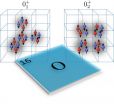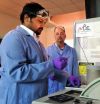(Press-News.org) Cardiovascular calcification (deposits of minerals in heart valves and blood vessels) is a primary contributor to heart disease, the leading cause of death among both men and women in the United States according the Centers for Disease Control and Prevention (CDC).
"Unfortunately, there currently is no medical treatment for cardiovascular calcification, which can lead to acute cardiovascular events, such as myocardial infarction and stroke, as well as heart failure," says Elena Aikawa, MD, PhD, Director of the Vascular Biology Program at the Center for Interdisciplinary Cardiovascular Sciences at Brigham and Women's Hospital (BWH) and Associate Professor of Medicine at Harvard Medical School. "We haven not found a way to reverse or slow this disease process, which is associated with aging and common chronic conditions like atherosclerosis, diabetes, and kidney disease."
Led by Dr. Aikawa, a team of researchers at BWH and Kowa Company, Ltd., a Japanese pharmaceutical company, has discovered certain proteins in osteoclasts, a precursor to bone, that may be used in helping to destroy cardiovascular calcification by dissolving mineral deposits. The research, described in the March 2014 issue of Arteriosclerosis, Thrombosis, and Vascular Biology, suggests a potential therapeutic avenue for patients with cardiovascular calcification.
Mature osteoclasts are not typically found in the vasculature. Using unbiased global proteomics (study of proteins), the researchers were able to examine osteoclast-like cells in the vasculature to determine which proteins induced osteoclast formation. They identified more than 100 proteins associated with osteoclast development. Follow-up study validated six candidate proteins, which serve as targets for possible medications that may help promote osteoclast development in the vasculature.
"To advance this research, we need to further understand why osteoclasts are not prevalent in the vaculature, despite active calcification of the heart valves and blood vessels, and determine the difference between calcification in vasculature compared with calcification in bone," said Dr. Aikawa. "Then, we may examine ways to form osteoclasts in the vasculature."
INFORMATION:
This study was supported by a research grant from Kowa Company, Ltd. (Tokyo, Japan) and the National Institutes of Health grants (R01HL114805, R01HL109506, and R01HL107550).
Novel marker and possible therapeutic target for cardiovascular calcification identified
Researchers from Brigham and Women's Hospital have discovered certain proteins in osteoclasts, a precursor to bone, that may be used in helping to destroy cardiovascular calcification by dissolving mineral deposits
2014-03-13
ELSE PRESS RELEASES FROM THIS DATE:
Robotic fish designed to perform escape maneuvers described in Soft Robotics journal
2014-03-13
New Rochelle, NY, March 13, 2014—A soft-bodied, self-contained robotic fish with a flexible spine that allows it to mimic the swimming motion of a real fish also has the built-in agility to perform escape maneuvers. The innovative design and capabilities of this complex, autonomous robot is described in Soft Robotics (SoRo), a new peer-reviewed journal from Mary Ann Liebert, Inc., publishers. The article is available free on the Soft Robotics website at http://www.liebertpub.com/soro.
Andrew Marchese, Cagdas Onal, and Daniela Rus, from MIT (Cambridge, MA) and Worcester ...
Mathematical and biochemical 'design features' for cell decoding of pulses revealed
2014-03-13
Every cell in the body has to sense and respond to chemicals such as hormones and neurotransmitters. They do so by relaying information from receptors to intracellular biochemical pathways that control cell behaviour, but relatively little is known about how cells decode the information in dynamic stimuli.
A team of researchers have found that differences in response kinetics working down the intracellular signalling pathway dictate differential sensitivity to different features of pulsatile hormone inputs.
The study funded by the BBSRC and published today [14 March] ...
Researchers describe oxygen's different shapes
2014-03-13
Oxygen-16, one of the key elements of life on earth, is produced by a series of reactions inside of red giant stars. Now a team of physicists, including one from North Carolina State University, has revealed how the element's nuclear shape changes depending on its state, even though other attributes such as spin and parity don't appear to differ. Their findings may shed light on how oxygen is produced.
Carbon and oxygen are formed when helium burns inside of red giant stars. Carbon-12 forms when three helium-4 nuclei combine in a very specific way (called the triple alpha ...
Creating a graphene-metal sandwich to improve electronics
2014-03-13
RIVERSIDE, Calif. — Researchers have discovered that creating a graphene-copper-graphene "sandwich" strongly enhances the heat conducting properties of copper, a discovery that could further help in the downscaling of electronics.
The work was led by Alexander A. Balandin, a professor of electrical engineering at the Bourns College of Engineering at the University of California, Riverside and Konstantin S. Novoselov, a professor of physics at the University of Manchester in the United Kingdom. Balandin and Novoselov are corresponding authors for the paper just published ...
UT Arlington research says treadmill workstation benefits employees, employers
2014-03-13
Employees who use treadmill workstations not only receive physical benefits but also are more productive at work, according to a recently published study by researchers from The University of Texas at Arlington, the Mayo Clinic and the University of Minnesota.
Darla Hamann, an assistant professor in the UT Arlington School of Urban and Public Affairs, and four colleagues wrote "Treadmill Workstations: The Effects of Walking while Working on Physical Activity and Work Performance", which was published by the journal PLoS One Feb. 20.
In the study, sedentary employees from ...
Heart scans only useful in prescribing statins under certain conditions, UCSF team reports
2014-03-13
As long as inexpensive statins, which lower cholesterol, are readily available and patients don't mind taking them, it doesn't make sense to do a heart scan to measure how much plaque has built up in a patient's coronary arteries before prescribing the pills, according to a new study by researchers at UC San Francisco.
The researchers created a statistical model to predict whether or not it made sense to do the scan, using data from the Multi-Ethnic Study of Atherosclerosis and other sources. They modeled the effects of statin treatment in 10,000 55-year-old women with ...
Researchers destroy cancer with cryoablation & nanoparticle-encapsulated anticancer drug
2014-03-13
Combining nanodrug-based chemotherapy and cryoablation provides an effective strategy to eliminate cancer stem-like cells (CSCs) the root of cancer resistance and metastasis, which will help to improve the safety and efficacy of treating malignancies that are refractory to conventional therapies.
Cryoablation (also called cryosurgery or cryotherapy) is an energy-based, minimally invasive surgical technique that has been investigated to treat a variety of diseases including cancer, which is done by freezing the diseased tissue to subzero temperature to induce irreversible ...
Same-day double knee replacement safe for select rheumatoid arthritis patients
2014-03-13
Same-day bilateral knee replacement surgery is safe for select patients with rheumatoid arthritis, researchers from Hospital for Special Surgery in New York have found.
Generally, patients with an inflammatory systemic disease such as rheumatoid arthritis (RA) are sicker than patients with the degenerative condition osteoarthritis (OA), says senior study author Mark Figgie, M.D., chief of the Surgical Arthritis Service at Hospital for Special Surgery, and the hospital's first Allan E. Inglis, MD, Chair in Surgical Arthritis.
RA patients are more likely to have conditions ...
Heat-based technique offers new way to measure microscopic particles
2014-03-13
Researchers have developed a new heat-based technique for counting and measuring the size of microscopic particles. The technique is less expensive than light-based techniques and can be used on a wider array of materials than electricity-based techniques. The research was performed by faculty at North Carolina State University, the University of North Carolina at Chapel Hill and Marquette University.
"We launched this study purely out of curiosity, but it's developed into a technique that has significant advantages over existing methods for counting and measuring the ...
A brake for spinning molecules
2014-03-13
This news release is available in German. Chemical reactions taking place in outer space can now be more easily studied on Earth. An international team of researchers from the University of Aarhus in Denmark and the Max Planck Institute for Nuclear Physics in Heidelberg, discovered an efficient and versatile way of braking the rotation of molecular ions. The spinning speed of these ions is related to a rotational temperature. Using an extremely tenuous, cooled gas, the researchers have lowered this temperature to about -265 °C. From this record-low value, the researchers ...
LAST 30 PRESS RELEASES:
Stardust study resets how life’s atoms spread through space
Practical education: Clinical scenario-based program development
The impact of family dynamics on eating behaviour – how going home for Christmas can change how you eat
Tracing the quick synthesis of an industrially important catalyst
New software sheds light on cancer’s hidden genetic networks
UT Health San Antonio awarded $3 million in CPRIT grants to bolster cancer research and prevention efforts in South Texas
Third symposium spotlights global challenge of new contaminants in China’s fight against pollution
From straw to soil harmony: International team reveals how biochar supercharges carbon-smart farming
Myeloma: How AI is redrawing the map of cancer care
Manhattan E. Charurat, Ph.D., MHS invested as the Homer and Martha Gudelsky Distinguished Professor in Medicine at the University of Maryland School of Medicine
Insilico Medicine’s Pharma.AI Q4 Winter Launch Recap: Revolutionizing drug discovery with cutting-edge AI innovations, accelerating the path to pharmaceutical superintelligence
Nanoplastics have diet-dependent impacts on digestive system health
Brain neuron death occurs throughout life and increases with age, a natural human protein drug may halt neuron death in Alzheimer’s disease
SPIE and CLP announce the recipients of the 2025 Advanced Photonics Young Innovator Award
Lessons from the Caldor Fire’s Christmas Valley ‘Miracle’
Ant societies rose by trading individual protection for collective power
Research reveals how ancient viral DNA shapes early embryonic development
A molecular gatekeeper that controls protein synthesis
New ‘cloaking device’ concept to shield sensitive tech from magnetic fields
Researchers show impact of mountain building and climate change on alpine biodiversity
Study models the transition from Neanderthals to modern humans in Europe
University of Phoenix College of Doctoral Studies releases white paper on AI-driven skilling to reduce burnout and restore worker autonomy
AIs fail at the game of visual “telephone”
The levers for a sustainable food system
Potential changes in US homelessness by ending federal support for housing first programs
Vulnerability of large language models to prompt injection when providing medical advice
Researchers develop new system for high-energy-density, long-life, multi-electron transfer bromine-based flow batteries
Ending federal support for housing first programs could increase U.S. homelessness by 5% in one year, new JAMA study finds
New research uncovers molecular ‘safety switch’ shielding cancers from immune attack
Bacteria resisting viral infection can still sink carbon to ocean floor
[Press-News.org] Novel marker and possible therapeutic target for cardiovascular calcification identifiedResearchers from Brigham and Women's Hospital have discovered certain proteins in osteoclasts, a precursor to bone, that may be used in helping to destroy cardiovascular calcification by dissolving mineral deposits





